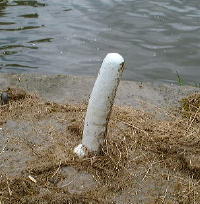Bosley
Bosley locks (1¼ miles)

Telford designed the canal with all its twelve locks in a short distance, only 1¼ miles, so as to improve efficiency of operation and maintenance. Two lock keepers could be employed to look after the whole flight, one living in the cottage beside the top lock and the other in the now demolished cottage beside lock 11. The design of the locks, too, reflects the state of the art for 1830. They are designed to be operated by two people - the boatman on the off side and the lock keeper on the towing path side. This is why they, possibly uniquely for a narrow canal, have double top gates.
Telford also designed the locks to be very heavy duty and therefore
very long lasting. The outstanding quality of the stonework is
evident to this day, making these some of the best built locks
on the network.
 Notice the curved iron spike, known as a blocking pin, in front of the offside top gates - the world's first automatic gearbox! This is where the boatman would hang the end of the towing strap (rope) prior to hauling the boat out of the filled lock. The strap would be taken around a pulley (the block) fixed to the towing mast on the boat and then to the horse or mule. This gave a 2:1 gearing enabling the animal more easily to get the boat moving. This arrangement also had the advantage of keeping the boat in the centre of the lock, making it easier to get it moving than if it were being pulled up against the stonework. As the boat passed the pin, the strap would lift off by itself and the end would run back to the block, so changing up a gear to 1:1. Notice the curved iron spike, known as a blocking pin, in front of the offside top gates - the world's first automatic gearbox! This is where the boatman would hang the end of the towing strap (rope) prior to hauling the boat out of the filled lock. The strap would be taken around a pulley (the block) fixed to the towing mast on the boat and then to the horse or mule. This gave a 2:1 gearing enabling the animal more easily to get the boat moving. This arrangement also had the advantage of keeping the boat in the centre of the lock, making it easier to get it moving than if it were being pulled up against the stonework. As the boat passed the pin, the strap would lift off by itself and the end would run back to the block, so changing up a gear to 1:1.
At the bottom end of the lock notice the steps used by the boatman to get on and off his boat. Possibly this aspect illustrates one of the very few design errors. The step is too far from the line of the boat for the boatman to reach. This required a timber platform to be built over the water to provide an intermediate step. The timber, of course, is not very long lasting and needs regular maintenance. Had Telford realised the problem, surely he would have designed the step to be built of stone as part of the lock structure. Notice too the shape of the hand rail. It has a horizontal turn just before the bottom. It is thought that this shape probably aids swinging round the bottom of the rail without having to remove and replace one's hold.
The farmhouse across the road from lock 5 used to be the Wheatsheaf inn, indeed, the area is known to this day as Wheatsheaf. The nearest pub now is a mile away in Bosley village; most regrettable! Mortar Mill House on the opposite bank of the canal is where mortar was mixed for the construction of the locks.
At locks 6 and 10 the Macclesfield Canal Society have installed seats in memory of friends of the canal - Dr. David & Pearl Owen and Stephanie Miller. Also on the offside of lock 6 there is a small stone lined pit. It is believed to be for soaking paddles. At lock 11 there used to be an orchard. The society have improved this to encourage new trees to grow and flowering cherries have been planted which provide a backdrop of colour each spring.
In the field beside the towing path at lock 11 there used to stand the bottom lock keeper's house. Only part of the foundations are visible today. Bill Shallcross was the last lock keeper to live here, moving to Hall Green lock cottage around 1950.
The abandoned railway was the North Staffordshire line from North Rode (near the top lock) up the Dane Valley, alongside Rudyard Lake to Leek and then down the beautiful Churnet valley to Uttoxeter. Much of it can be walked, but not here at the locks. Join the path by Hug Bridge, where the track crosses the Dane and the Staffordshire Way joins the Gritstone Trail.
The glorious view along lock 12 towards the hill known as The Cloud NT is well known and delightful. There was a quarry on the face of the hill which was the source of the stone for the locks. The stone is thought to have been brought down by tramway but no remains have ever been found. A reservoir was built in the quarry in the 1950's. Some 4,000 years earlier, The Cloud was well populated, a hill fort and settlement having been discovered. Nearby is The Bridestones, a burial chamber.
Extra - Side ponds
Extra - Reservoirs and feeders
Extra - Lock 6 pit
Next page - Buglawton.
|